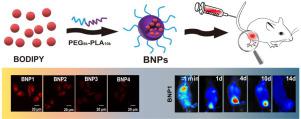Acta Biomaterialia ( IF 9.4 ) Pub Date : 2020-05-17 , DOI: 10.1016/j.actbio.2020.05.013 Ya Su 1 , Chunyan Lv 2 , Yujian Zhang 2 , Shi Liu 3 , Zhigang Xie 4 , Min Zheng 1

|
Recently, organic dyes with aggregation-induced emission (AIE) have attracted much attention in bioimaging and diagnostics. Relatively, the application of traditional dyes has diminished because of aggregation-caused quenching (ACQ). In this work, we compare the imaging ability of nanoparticle formulations of these two kinds of dyes. Boron dipyrromethene (BODIPY) was chosen as a representative of the ACQ dyes, and an aggregation-induced emission (AIE) dye BPMT was used for comparison. BODIPY and BPMT were entrapped into PEG5k-PLA10k to form BODIPY-loaded NPs (BNPs) and BPMT-loaded NPs (ANPs), respectively. In vivo and ex vivo imaging demonstrated that BNP1 with ultralow BODIPY load (0.07%) can effectively accumulate in tumor tissues and enable long-term noninvasive imaging. In contrast, ANP4 with high BPMT load (1.6%) has poor bioimaging ability. In general, our work has certain reference significance for the application of ACQ dyes and AIEgens in bioimaging, diagnostics, and theranostics.
Statement of Significance
In this work, Boron dipyrromethene (BODIPY) was chosen as a representative of ACQ dyes. As a control, (Z)-2-(4′-(9H-carbazol-9-yl)-[1,1′-biphenyl]-4-yl)-3-(7-(4-(bis(4methoxyphenyl)amino) phenyl) benzo[c] [1,2,5] thiadiazol-4-yl) acrylonitrile (BPMT) was selected as an aggregation-induced emission (AIE) dye. BODIPY and BPMT was entrapped into PEG5k-PLA10k to form BODIPY-loaded NPs (BNPs) and BPMT-loaded NPs (ANPs), respectively. In vivo and ex vivo imaging demonstrated that BNP1 with ultralow BODIPY load (0.07%) can effectively accumulate in tumor tissues and realize long-term noninvasive imaging. The weaknesses of ACQ effect can be converted into advantages by skillful use of nanotechnology, which can not only save the cost but also realize high efficiency targeted cancer imaging.
中文翻译:

具有超低发色团负载的荧光纳米颗粒,可用于长期肿瘤靶向成像。
最近,具有聚集诱导发射(AIE)的有机染料已在生物成像和诊断领域引起了广泛关注。相对而言,由于聚集引起的猝灭(ACQ),传统染料的应用有所减少。在这项工作中,我们比较了这两种染料的纳米颗粒制剂的成像能力。选择硼二吡咯亚甲基(BODIPY)作为ACQ染料的代表,并使用聚集诱导发射(AIE)染料BPMT进行比较。BODIPY和BPMT被困在PEG 5k -PLA 10k中分别形成BODIPY负载的NP(BNP)和BPMT负载的NP(ANP)。体内和离体成像显示具有超低BODIPY负荷(0.07%)的BNP1可以有效地积聚在肿瘤组织中,并可以进行长期无创成像。相反,BPMT负荷高(1.6%)的ANP4的生物成像能力较差。通常,我们的工作对于ACQ染料和AIEgens在生物成像,诊断和诊断学中的应用具有一定的参考意义。
重要声明
在这项工作中,硼二吡咯亚甲基(BODIPY)被选作ACQ染料的代表。作为对照,(Z)-2-(4'-(9H-咔唑-9-基)-[1,1'-联苯] -4-基)-3-(7-(4-(双(4-甲氧基苯基) )氨基)苯基)苯并[c] [1,2,5]噻二唑-4-基)丙烯腈(BPMT)被选为聚集诱导发射(AIE)染料。将BODIPY和BPMT包裹在PEG5k-PLA10k中,以分别形成BODIPY装载的NP(BNP)和BPMT装载的NP(ANP)。体内和离体成像表明具有超低BODIPY负荷(0.07%)的BNP1可以有效地积聚在肿瘤组织中,并实现长期无创成像。通过熟练使用纳米技术,可以将ACQ效果的弱点转化为优势,这不仅可以节省成本,而且可以实现高效的靶向癌症成像。











































 京公网安备 11010802027423号
京公网安备 11010802027423号